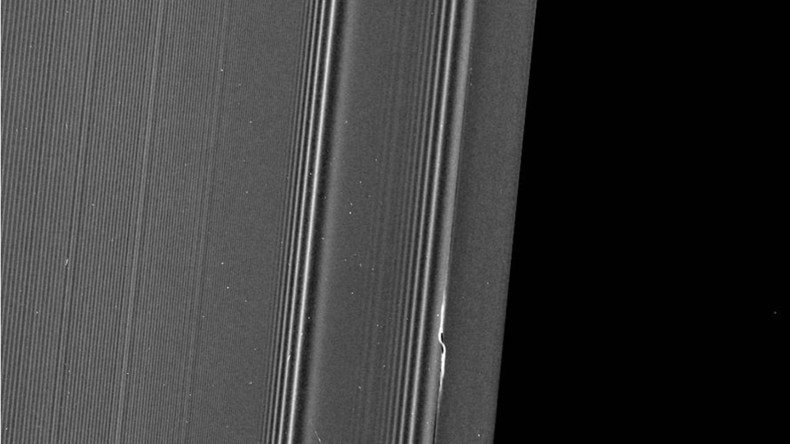‘Disturbances’ in Saturn’s rings snapped by Cassini (PHOTO)

The Cassini space probe, which has been studying Saturn since 2004, has snapped a stunning photo of “disturbances” in the gas giant’s rings in much higher resolution than ever before.
The unmanned spacecraft captured the image from a distance of nearly 70,000 miles (111,340 kilometers) as it cruised past on March 22.
It shows the unusual phenomenon, known as a “propeller,” which is created by small moons or ‘moonlets’ clearing a space around them in the debris ring encircling Saturn. This particular propeller has been informally named “Earhart.”
The photo was taken looking toward the sunlit side of the rings.
Propellers, or disturbances in Saturn’s rings, are seen in this @CassiniSaturn pic taken during a ring-grazing orbit https://t.co/kwNqeOICvhpic.twitter.com/3L79PfQsAE
— NASA (@NASA) April 1, 2017
Earhart is situated very close to the 200-mile-wide (320-kilometer-wide) Encke Gap – a gap in the rings held open by the moon Pan, which is much larger than the moonlet that created Earhart. The dark region on the right hand side of the photo shows a portion of the Encke Gap.
READ MORE: NASA’s new Mars drone to scout for human habitation sites (VIDEO)
“The gap and the propeller are a study in contrasts. The propeller is nothing more than Earhart’s attempt to open a gap like Encke using its gravity,” NASA explained in a statement.
“However, Earhart’s attempt is thwarted by the mass of the ring, which fills in the nascent gap before it can extend very far. Pan is a few thousand times more massive than Earhart, which enables it to maintain a gap that extends all the way around the ring.”
The image also shows wave features caused by three of Saturn’s other moons, Pandora, Prometheus, and Pan.
#SaturnSaturday ICYMI We’re now grazing #Saturn’s rings. What’s next? Our #GrandFinale. Everything you need to know: https://t.co/TSA7uQe4KSpic.twitter.com/Fu7fpikVyD
— CassiniSaturn (@CassiniSaturn) April 1, 2017
The Cassini mission is a cooperative project between NASA, the European Space Agency (ESA) and the Italian Space Agency. The $3.2 billion mission was launched in 1997 and will come to an end later this year when the probe dives into Saturn’s atmosphere, sending as much data as possible back to Earth until it loses signal. This final chapter of the mission has been dubbed the “Grand finale” by NASA.
The craft dropped a lander named Huygens on Saturn’s largest moon, Titan in January 2005, which discovered a global ocean on the planet’s sixth largest moon, Enceladus.












